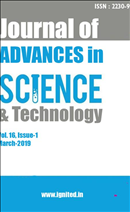Identification and Validation of Sex Specific DNA Markers in Date Palm (Phoenix Dactylifera L.) Using RAPD Markers
Identifying sex-specific DNA markers for efficient date palm cultivation
Keywords:
date palm, DNA markers, RAPD markers, sex-specific, cultivation, yield, genotypic identification, primers, male and female genotypes, progenyAbstract
Date palm (Phoenix dactylifera L.) is a dioecious long-lived mono-cotyledoneous woody perennial belonging to Palmae (Arecaceae) family with chromosome number 2n=36. Date palm (Phoenix dactylifera L.) is an important fruit crop mostly grown in the regions of Africa, the Middle East and South Asia. In India date palm cultivation has taken hike in production many dry areas are farming for export quality date in regions of Gujarat and Maharashtra. In India, nearly 0.3 million ha of land can be effectively utilized for date palm cultivation the extremely dry areas comprising of Jaisalmer, Barmer and Western parts of Bikaner and Jodhpur districts are the potential regions for its cultivation.Date fruit is rich in sugar, iron, potassium, calcium and nicotinic acid. Fresh dates per kg provide approximately 3,150 calories. The dry flesh of the ripe date contains about 80 sugar, 2.5 fibre, 2 protein and 2 each of fat, minerals and pectic substances. There are many other products which can be prepared using date fruits such as syrups, jams, ice cream, alcoholic beverages and soft drinks the leaves of palm are used in the manufacture of paper. Main issue in cultivation of date palm is yield which is reduced by increased in no of male plants during cultivation. During establishment of plantations, male and female cannot be clearly distinguished until five years after cultivation. Date palm is slow growing and it is difficult to determine the sex of the trees before the flowering. This major problem for farmers does not allow them to cultivate sufficiently large number of productive female trees with only a minimal number of male trees as one male is sufficient to pollinate 50 females when grown together. Thus the establishment of an efficient date palm selection programme requires the identification of suitable markers for the early assessment of the sex of the progeny. Molecular analysis of genotypic markers offers an attractive, reliable alternative method in identifying plants at early growth stage. So we screened for 30 RAPD primers for identification of male and female sex specific primers in which highly polymorphic primers found in OPB-20, OPB-15 and OPA-05 compared to other RAPD primers. Three primers we found capable of efficiently differentiating the male genotypes from the females of date palm. The ability to differentiate most of the tested male and female genotypes by the RAPD markers suggested that this technique is practically applicable for date-palm genotypic identificationDownloads
Download data is not yet available.
Published
2019-03-01
Issue
Section
Articles






